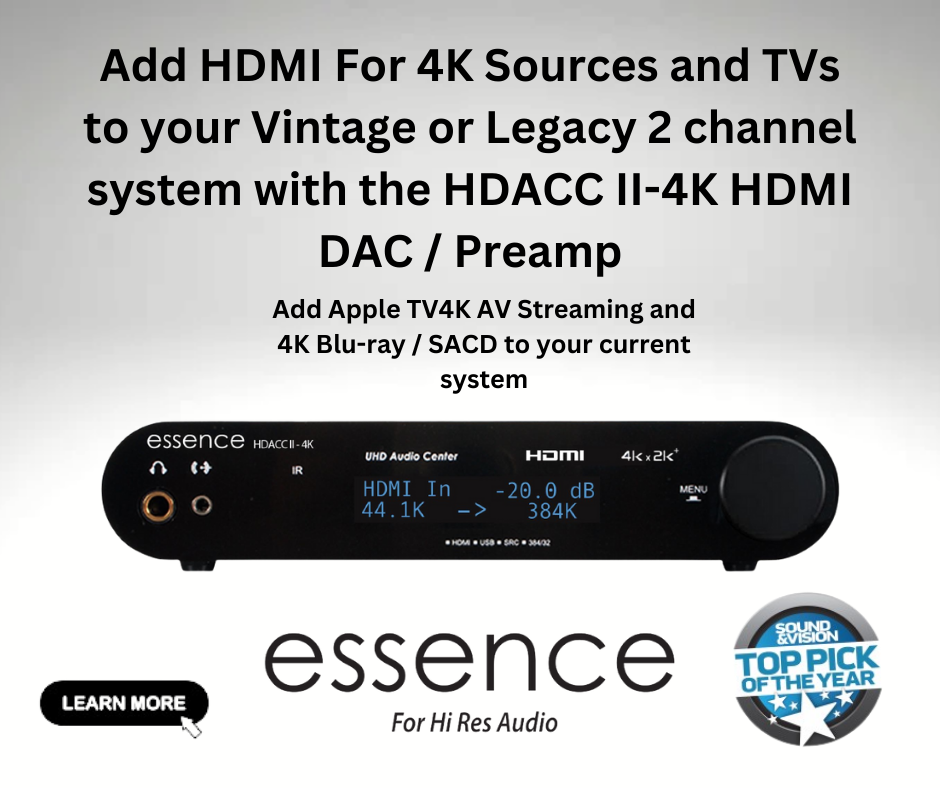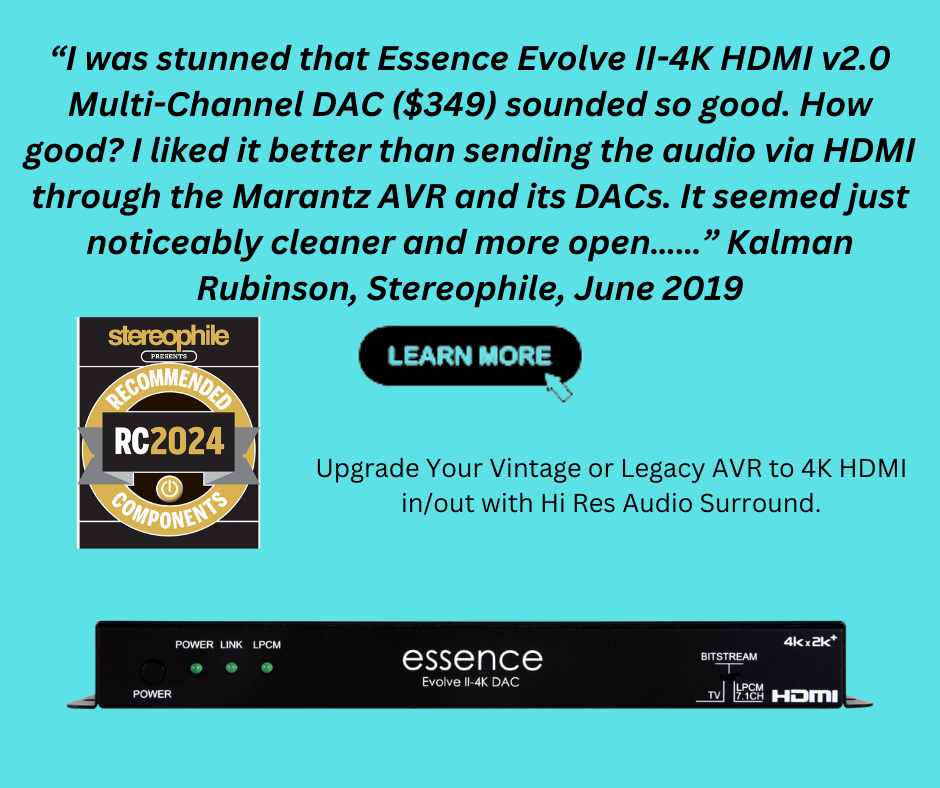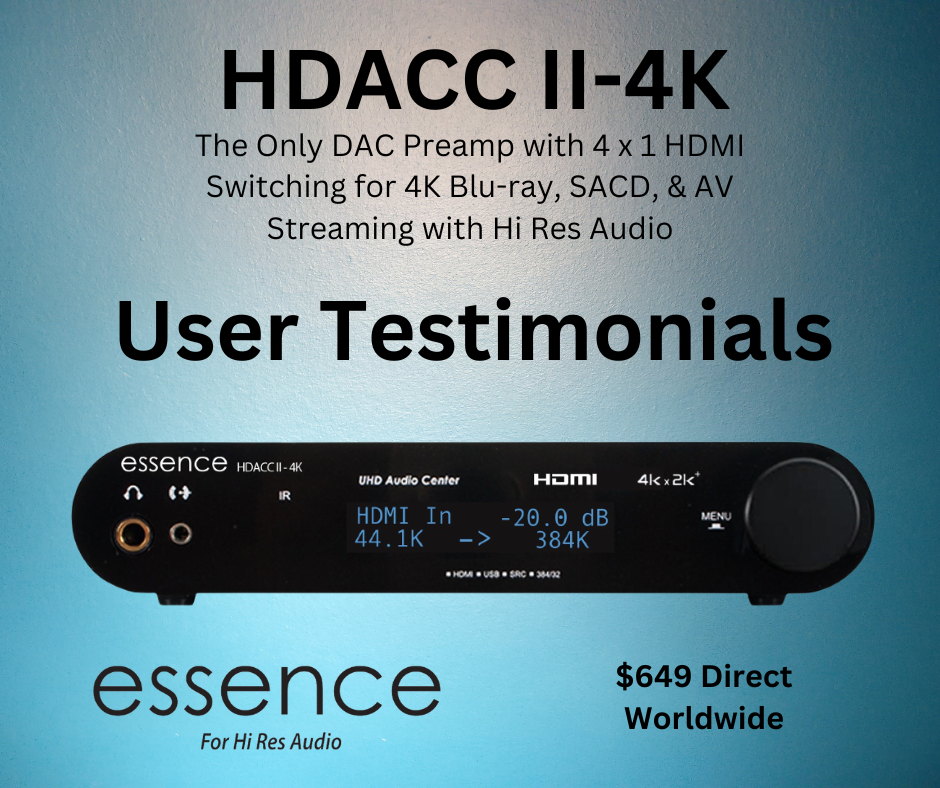Bob Rapoport
Music Reviewer
Thread Starter
- Joined
- Jan 29, 2018
- Posts
- 34
More
- Preamp, Processor or Receiver
- Essence HDACC II-4K
- Main Amp
- Essence DPA-440
- Universal / Blu-ray / CD Player
- Sony 4K
- Front Speakers
- Essence Electrostats
- Center Channel Speaker
- Essence
- Surround Speakers
- Essence
- Subwoofers
- Essence
- Screen
- Screen Goo painted screen, 4 coats
- Video Display Device
- Vizio M70
- Remote Control
- Essence
High Fidelity signifies a reproduction that remains "true to the original recording," essentially a flawless, one-to-one copy that preserves the full bandwidth and dynamic range of the original master.
The quest for high-fidelity audio has been a captivating journey. Since the 1970s, audiophiles have aspired to replicate the experience of hearing a perfect copy of the master recording in their homes, capturing its original bandwidth and dynamic range.
Vinyl records, constrained by a limited bandwidth of 100Hz to 16KHz and a 60 dB dynamic range due to storage limitations, fall short. The original magnetic master tapes boasted a far greater bandwidth and dynamic range, rendering vinyl a "lossy" medium. Although equalization curves in phono preamps could recover some of the lost bandwidth, the diminished dynamic range resulted in a noticeable reduction in impact and realism.
While 2" magnetic tape running at 15 IPS could achieve a bandwidth of 20Hz to 20KHz with an 85 dB dynamic range, vinyl records were compressed to 60 dB to accommodate six songs per side on a double-sided disc, allowing only 20 minutes per side. Nevertheless, vinyl retained—and continues to possess—a certain allure that sustains its popularity even today.
The introduction of digital CDs by Sony and Philips in 1984 marked a major advancement, offering a single-sided 5" disc with 74 minutes of playback time. With an expanded bandwidth of 20Hz to 20KHz and a dynamic range of 90 dB, CDs provided a superior listening experience compared to vinyl. However, CDs still cannot store today's full digital 5 Gb masters, as they are limited to 700 Mb of data.
Sony's DVD format, launched in 1997, offered increased storage capacity at 5 Gb with a 110 dB dynamic range. In 2000, Sony introduced SACD, a music-specific format capable of storing a complete, one-to-one copy of the original 5 Gb master recording. SACD became the first format to achieve the audiophile's high-fidelity dream. Because a standard studio album's master recording is typically a 5 Gb file, SACD could store the entire file without compression, achieving a dynamic range of 110 dB over 84 minutes.
In 2008, Sony's Blu-ray format further expanded storage capabilities to 50 Gb, featuring a 120 dB dynamic range over 2.5 hours. This allowed for high-definition video and uncompressed, hi-res multichannel soundtracks. However, concerns about unauthorized copying prompted studios and record labels to develop HDMI connectivity with HDCP digital security protocols to protect against copyright infringement and piracy. Intel was contracted to create an encrypted data transfer protocol, HDCP, which authenticates a secure connection between the source and the playback device.
By 2017, Sony had released Ultra HD Blu-ray, which doubled the storage capacity to 100 Gb and supported 4K video along with immersive audio formats like Atmos. Atmos is an object-based surround format derived from metadata that adds height channels mounted on the ceiling between the listening position and the main left and right front channels. 4K Blu-rays now can store up to three hours of content without compression.
Since 2017, we have been at the cutting edge, and the rollout of 4K TVs is gaining momentum. UHD TVs offer large screen sizes to maximize the impact of 4K content's increased data. A 65" diagonal screen viewed from 8-10 feet provides a more immersive experience than your local movie theater, enhanced by superior audio. Larger rooms benefit from 75" and 85" screens.
The quest for high-fidelity audio has been a captivating journey. Since the 1970s, audiophiles have aspired to replicate the experience of hearing a perfect copy of the master recording in their homes, capturing its original bandwidth and dynamic range.
Vinyl records, constrained by a limited bandwidth of 100Hz to 16KHz and a 60 dB dynamic range due to storage limitations, fall short. The original magnetic master tapes boasted a far greater bandwidth and dynamic range, rendering vinyl a "lossy" medium. Although equalization curves in phono preamps could recover some of the lost bandwidth, the diminished dynamic range resulted in a noticeable reduction in impact and realism.
While 2" magnetic tape running at 15 IPS could achieve a bandwidth of 20Hz to 20KHz with an 85 dB dynamic range, vinyl records were compressed to 60 dB to accommodate six songs per side on a double-sided disc, allowing only 20 minutes per side. Nevertheless, vinyl retained—and continues to possess—a certain allure that sustains its popularity even today.
The introduction of digital CDs by Sony and Philips in 1984 marked a major advancement, offering a single-sided 5" disc with 74 minutes of playback time. With an expanded bandwidth of 20Hz to 20KHz and a dynamic range of 90 dB, CDs provided a superior listening experience compared to vinyl. However, CDs still cannot store today's full digital 5 Gb masters, as they are limited to 700 Mb of data.
Sony's DVD format, launched in 1997, offered increased storage capacity at 5 Gb with a 110 dB dynamic range. In 2000, Sony introduced SACD, a music-specific format capable of storing a complete, one-to-one copy of the original 5 Gb master recording. SACD became the first format to achieve the audiophile's high-fidelity dream. Because a standard studio album's master recording is typically a 5 Gb file, SACD could store the entire file without compression, achieving a dynamic range of 110 dB over 84 minutes.
In 2008, Sony's Blu-ray format further expanded storage capabilities to 50 Gb, featuring a 120 dB dynamic range over 2.5 hours. This allowed for high-definition video and uncompressed, hi-res multichannel soundtracks. However, concerns about unauthorized copying prompted studios and record labels to develop HDMI connectivity with HDCP digital security protocols to protect against copyright infringement and piracy. Intel was contracted to create an encrypted data transfer protocol, HDCP, which authenticates a secure connection between the source and the playback device.
By 2017, Sony had released Ultra HD Blu-ray, which doubled the storage capacity to 100 Gb and supported 4K video along with immersive audio formats like Atmos. Atmos is an object-based surround format derived from metadata that adds height channels mounted on the ceiling between the listening position and the main left and right front channels. 4K Blu-rays now can store up to three hours of content without compression.
Since 2017, we have been at the cutting edge, and the rollout of 4K TVs is gaining momentum. UHD TVs offer large screen sizes to maximize the impact of 4K content's increased data. A 65" diagonal screen viewed from 8-10 feet provides a more immersive experience than your local movie theater, enhanced by superior audio. Larger rooms benefit from 75" and 85" screens.
Last edited:










